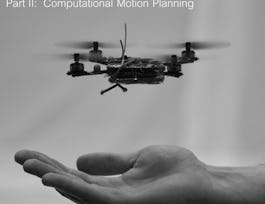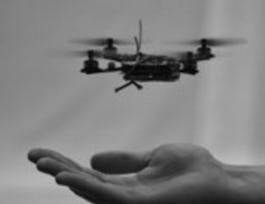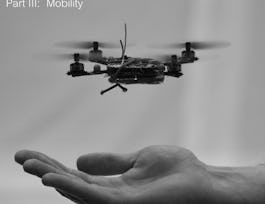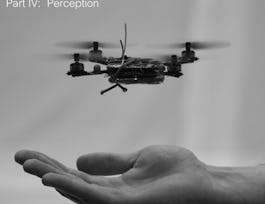How can we create agile micro aerial vehicles that are able to operate autonomously in cluttered indoor and outdoor environments? You will gain an introduction to the mechanics of flight and the design of quadrotor flying robots and will be able to develop dynamic models, derive controllers, and synthesize planners for operating in three dimensional environments. You will be exposed to the challenges of using noisy sensors for localization and maneuvering in complex, three-dimensional environments. Finally, you will gain insights through seeing real world examples of the possible applications and challenges for the rapidly-growing drone industry.



Robotics: Aerial Robotics
This course is part of Robotics Specialization

Instructor: Vijay Kumar
143,997 already enrolled
Included with 
(3,070 reviews)
Skills you'll gain
Details to know

Add to your LinkedIn profile
5 quizzes, 1 assignment
See how employees at top companies are mastering in-demand skills

Build your subject-matter expertise
- Learn new concepts from industry experts
- Gain a foundational understanding of a subject or tool
- Develop job-relevant skills with hands-on projects
- Earn a shareable career certificate


Earn a career certificate
Add this credential to your LinkedIn profile, resume, or CV
Share it on social media and in your performance review

There are 4 modules in this course
Welcome to Week 1! In this week, you will be introduced to the exciting field of Unmanned Aerial Robotics (UAVs) and quadrotors in particular. You will learn about their basic mechanics and control strategies and realize how careful component selection and design affect the vehicles' performance. This week also provides you with instructions on how to download and install Matlab. This software will be used throughout this course in exercises and assignments, so it is strongly recommended to familiarize yourself with Matlab soon. Tutorials to help you get started are also provided in this week.
What's included
16 videos5 readings2 quizzes1 assignment
Welcome to Week 2 of the Robotics: Aerial Robotics course! We hope you are having a good time and learning a lot already! In this week, we will first focus on the kinematics of quadrotors. Then, you will learn how to derive the dynamic equations of motion for quadrotors. To build a better understanding on these notions, some essential mathematical tools are discussed in supplementary material lectures. In this week, you will also complete your first programming assignment on 1-D quadrotor control. If you have not done so already, please download, install, and learn about Matlab before starting the assignment.
What's included
19 videos1 quiz1 programming assignment
Welcome to Week 3! We have developed planar and three-dimensional dynamic models of the quadrotor. This week, you will learn more about how to develop linear controllers for these models. With this knowledge, you will be required to complete the second programming assignment of this course, which focuses on controlling the quadrotor in two dimensions. We encourage you to start working on the assignment soon. This week ends with a discussion on motion planning for quadrotors.
What's included
9 videos1 quiz1 programming assignment
Welcome to Week 4! So far, we have gone over the basics of developing linear controllers for quadrotors and motion planning. In this last week of the course, we will discuss some more advanced material on how to enable quadrotors to perform more agile maneuvers and to operate autonomously in teams. Note that the last programming assignment on quadrotor control in three dimensions uses material from the previous weeks. It is strongly recommended to start the assignment as soon as possible.
What's included
5 videos1 reading1 quiz1 programming assignment
Instructor

Offered by
Recommended if you're interested in Mechanical Engineering

University of Pennsylvania

University of Pennsylvania

University of Pennsylvania

University of Pennsylvania
Why people choose Coursera for their career




Learner reviews
Showing 3 of 3070
3,070 reviews
- 5 stars
67.92%
- 4 stars
23.22%
- 3 stars
4.52%
- 2 stars
1.82%
- 1 star
2.50%

Open new doors with Coursera Plus
Unlimited access to 7,000+ world-class courses, hands-on projects, and job-ready certificate programs - all included in your subscription
Advance your career with an online degree
Earn a degree from world-class universities - 100% online
Join over 3,400 global companies that choose Coursera for Business
Upskill your employees to excel in the digital economy
Frequently asked questions
Access to lectures and assignments depends on your type of enrollment. If you take a course in audit mode, you will be able to see most course materials for free. To access graded assignments and to earn a Certificate, you will need to purchase the Certificate experience, during or after your audit. If you don't see the audit option:
The course may not offer an audit option. You can try a Free Trial instead, or apply for Financial Aid.
The course may offer 'Full Course, No Certificate' instead. This option lets you see all course materials, submit required assessments, and get a final grade. This also means that you will not be able to purchase a Certificate experience.
When you enroll in the course, you get access to all of the courses in the Specialization, and you earn a certificate when you complete the work. Your electronic Certificate will be added to your Accomplishments page - from there, you can print your Certificate or add it to your LinkedIn profile. If you only want to read and view the course content, you can audit the course for free.
If you subscribed, you get a 7-day free trial during which you can cancel at no penalty. After that, we don’t give refunds, but you can cancel your subscription at any time. See our full refund policy.

